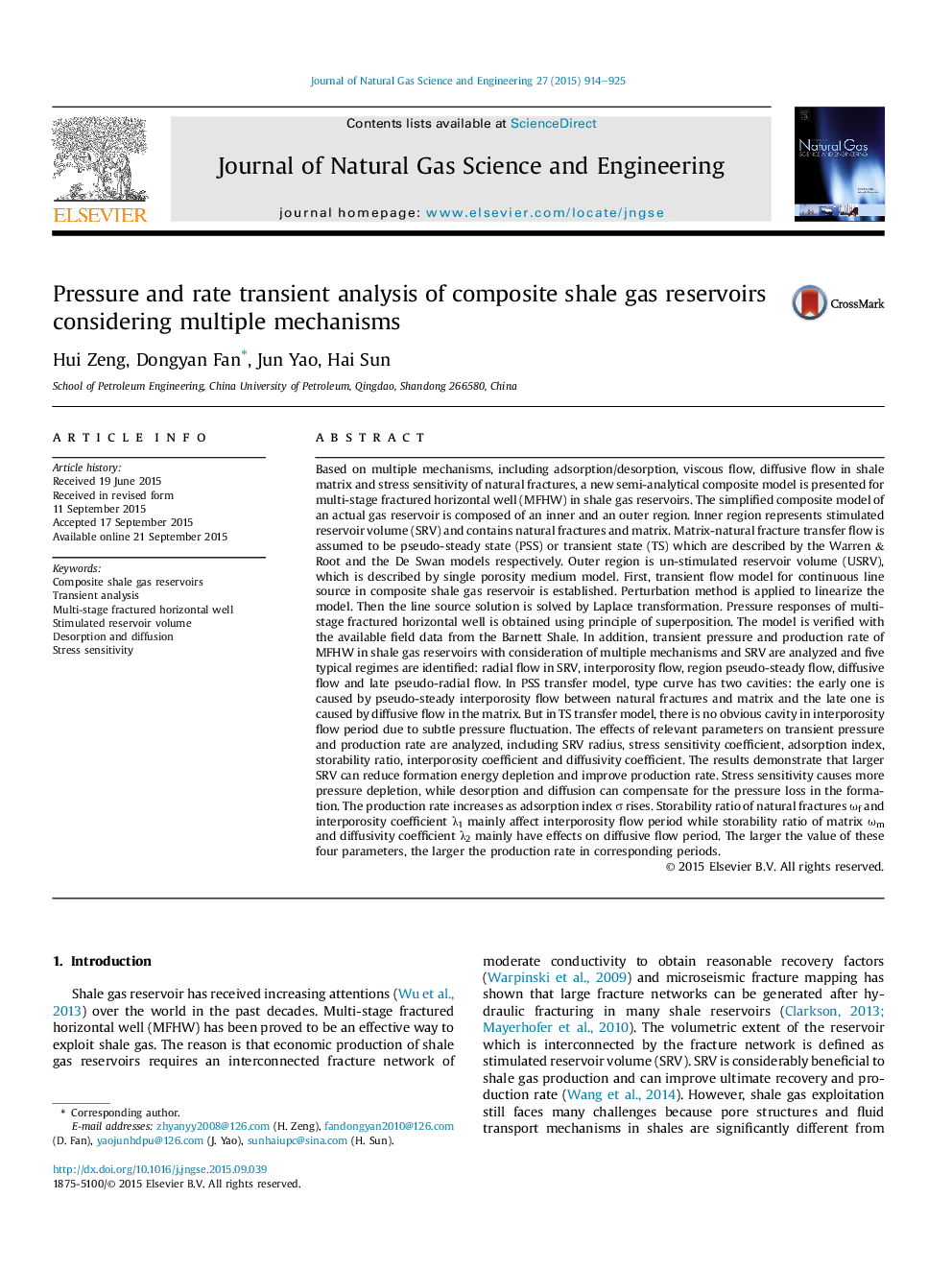| کد مقاله | کد نشریه | سال انتشار | مقاله انگلیسی | نسخه تمام متن |
|---|---|---|---|---|
| 1757639 | 1019129 | 2015 | 12 صفحه PDF | دانلود رایگان |
عنوان انگلیسی مقاله ISI
Pressure and rate transient analysis of composite shale gas reservoirs considering multiple mechanisms
ترجمه فارسی عنوان
تجزیه و تحلیل فشار و سرعت گذار از مخازن گاز شیل کامپوزیت با توجه به مکانیزم های متعدد
دانلود مقاله + سفارش ترجمه
دانلود مقاله ISI انگلیسی
رایگان برای ایرانیان
کلمات کلیدی
مخازن گاز شیل کامپوزیت، تجزیه و تحلیل گذرا، چند مرحله چاه افقی شکستن، حجم مخزن تحریک شده، جذب و انتشار، حساسیت استرس
موضوعات مرتبط
مهندسی و علوم پایه
علوم زمین و سیارات
علوم زمین و سیاره ای (عمومی)
چکیده انگلیسی
Based on multiple mechanisms, including adsorption/desorption, viscous flow, diffusive flow in shale matrix and stress sensitivity of natural fractures, a new semi-analytical composite model is presented for multi-stage fractured horizontal well (MFHW) in shale gas reservoirs. The simplified composite model of an actual gas reservoir is composed of an inner and an outer region. Inner region represents stimulated reservoir volume (SRV) and contains natural fractures and matrix. Matrix-natural fracture transfer flow is assumed to be pseudo-steady state (PSS) or transient state (TS) which are described by the Warren & Root and the De Swan models respectively. Outer region is un-stimulated reservoir volume (USRV), which is described by single porosity medium model. First, transient flow model for continuous line source in composite shale gas reservoir is established. Perturbation method is applied to linearize the model. Then the line source solution is solved by Laplace transformation. Pressure responses of multi-stage fractured horizontal well is obtained using principle of superposition. The model is verified with the available field data from the Barnett Shale. In addition, transient pressure and production rate of MFHW in shale gas reservoirs with consideration of multiple mechanisms and SRV are analyzed and five typical regimes are identified: radial flow in SRV, interporosity flow, region pseudo-steady flow, diffusive flow and late pseudo-radial flow. In PSS transfer model, type curve has two cavities: the early one is caused by pseudo-steady interporosity flow between natural fractures and matrix and the late one is caused by diffusive flow in the matrix. But in TS transfer model, there is no obvious cavity in interporosity flow period due to subtle pressure fluctuation. The effects of relevant parameters on transient pressure and production rate are analyzed, including SRV radius, stress sensitivity coefficient, adsorption index, storability ratio, interporosity coefficient and diffusivity coefficient. The results demonstrate that larger SRV can reduce formation energy depletion and improve production rate. Stress sensitivity causes more pressure depletion, while desorption and diffusion can compensate for the pressure loss in the formation. The production rate increases as adsorption index Ï rises. Storability ratio of natural fractures Ïf and interporosity coefficient λ1 mainly affect interporosity flow period while storability ratio of matrix Ïm and diffusivity coefficient λ2 mainly have effects on diffusive flow period. The larger the value of these four parameters, the larger the production rate in corresponding periods.
ناشر
Database: Elsevier - ScienceDirect (ساینس دایرکت)
Journal: Journal of Natural Gas Science and Engineering - Volume 27, Part 2, November 2015, Pages 914-925
Journal: Journal of Natural Gas Science and Engineering - Volume 27, Part 2, November 2015, Pages 914-925
نویسندگان
Hui Zeng, Dongyan Fan, Jun Yao, Hai Sun,
